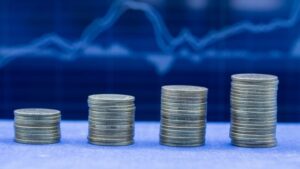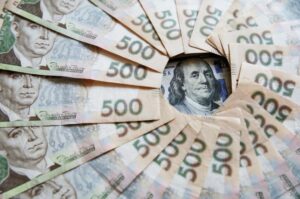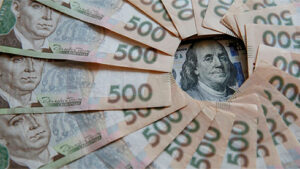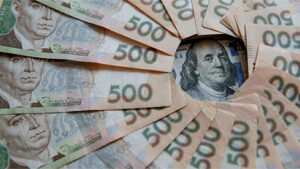
After raising the official hryvnia exchange rate by 4 kopecks on Thursday, the National Bank of Ukraine (NBU) strengthened it by another 5 kopecks on Friday to 41.6070 UAH/$1, according to the regulator’s website.
“The foreign exchange market of Ukraine is experiencing an increase in the currency deficit caused by high demand in both cash and non-cash segments. The National Bank of Ukraine stabilizes the market with interventions that are not able to fully satisfy the demand for currency, but at the same time achieve the goal of stabilizing the market, which prevents abrupt dynamics and allows to maintain a smooth devaluation trend,” analysts of KIT Group state in the review and forecast of the foreign exchange market.
According to them, the increase in demand for foreign currency in both segments of the foreign exchange market is typical for the beginning of the month and the end of the year.
The analysts also note that the spread between the buying and selling rates of the euro and the US dollar has increased in recent weeks.
“This indicates the desire of currency market operators to capitalize on the increased demand for cash currency among the population, and the widening of the difference between the purchase and sale rates allows them to compensate for their own risks amid a poorly predictable exchange rate situation,” they explain.
At the same time, KIT Group believes that statements by Ukraine’s international partners regarding further funding from frozen natural resources, infrastructure support and economic stimulus projects do not give rise to pessimistic exchange rate forecasts.
According to their expectations, in the short term, the hryvnia exchange rate against the dollar will remain in the range of 41.7-42 UAH/$1, with a tendency to gravitate towards 42.5 UAH/$1. “Quotations close to 42 UAH/$1 were already recorded in early December, which is in line with our exchange rate expectations for the end of this year. At the same time, seasonal factors, such as increased demand for foreign currency at the end of the year, may cause a slight short-term surge to 42.5 UAH/$1,”KIT Group” forecasts.
However, at the same time, recent changes in tax policy may increase the tax burden on deposit income, which could stimulate additional demand for foreign currency and the flow of foreign currency savings from the banking system into cash, thereby putting pressure on the hryvnia exchange rate.
The NBU set the reference rate at 12:00 on Friday at 41.5778 UAH/$1, compared to 41.6915 UAH/$1 a day earlier.
The US dollar on the cash market on Friday rose by 4 kopecks to 41.84 UAH/$1 when buying, and by 5 kopecks to 41.90 UAH/$1 when selling.
Overall, since the beginning of 2024, the dollar has risen by 9.5%, or UAH 3.60, at the official exchange rate, and by 13.8%, or UAH 5.03, since the National Bank switched to a managed flexibility regime on October 3, 2023.
The average annual exchange rate is set at 40.7 UAH/$1 in the budget for 2024, and 42.1 UAH/$1 at the end of this year.
As reported, the official hryvnia exchange rate fell by 0.9%, or 37 kopecks, over the past month.
At the same time, Ukraine’s international reserves in November increased by $3.344 billion, or 9.1%, and as of December 1, 2024, according to preliminary data from the central bank, amounted to $39.925 billion, while net international reserves (NIR) increased by $3.5 billion, or 15.6%, to $25 billion 939 million.
The NBU’s net sale of foreign currency on the interbank market last week increased to $785.4 million, compared to $708.5 million a week earlier.
Source: https://ru.interfax.com.ua/news/projects/1033645.html

Issue No. 1 for November 2024
The global currency market was shaken by Donald Trump’s victory in the US presidential election, which created a wave of expectations and uncertainty.
The real balance of power will become clearer only after the first practical steps of the new administration, which will indicate the key vectors of the US economy, determine their global influence on allied countries and blocs, and show the policy of influencing the US global competitors outside the Western world.
Currently, there are no fundamental economic reasons for significant exchange rate corrections, and what we are seeing in the global context in the currency and cryptoasset markets is more like “fussing on deck waiting for the weather to change,” although there is no clear forecast or signs of change, everything is based on more or less probable assumptions, expectations, and faith.
Now is not the best time to formulate medium-term currency strategies. However, if you have developed speculative skills and a taste for risk, you can make money from speculation in a period of high uncertainty in the currency markets.
Meanwhile, Ukraine is experiencing record demand for foreign currency, which is also driven more by global processes and the far from optimistic expectations of households and businesses. The real need for foreign currency can only exist and grow in the shadow sector, where some business operations are moved in the face of economic and tax uncertainty, infrastructure and economic risks. However, the real needs for foreign currency for import-oriented sectors are within normal limits.
Thus, Ukraine’s FX market remains under pressure from psychological factors, although fundamental macroeconomic indicators do not yet provide grounds for strong devaluation pressure and abrupt exchange rate movements. The only certainty is that we will see further gradual devaluation of the hryvnia, at least in the current security and economic environment.
The combination of these factors is pushing citizens to transfer their savings into foreign currency instruments, and many are focused on cryptocurrencies.
Dollar exchange rate forecast
As we predicted earlier, the US dollar exchange rate remained relatively stable in November with minor fluctuations. The average buying rate fluctuated between 41.20 and 41.35 UAH/$, and the selling rate between 41.65 and 41.75 UAH/$. The official NBU exchange rate remained at UAH 41.20-41.35/$ amid no significant interventions by the regulator.
The spread between the bid and ask rates remained stable at UAH 0.40-0.50/$, reflecting the fragile economic equilibrium and the balance between supply and demand.
Outlook:
Euro exchange rate forecast
As expected, the euro continues to show a steady downward trend after reaching peak levels of 46.18-45.6 UAH/€ in October. In the second decade of November, the average euro exchange rate corrected from 45.25-44.67 UAH/€ to 44.65-44.1 UAH/€.
The downward spread between buying and selling euros remained relatively flat at UAH 0.55-0.65/€, indicating that FX market operators are trying to keep an additional premium on the increased demand for the euro, while the purchase of euros from households and businesses is closer to the official NBU rate, the unwillingness of FX market operators to take on currency risk in the event of a reverse “rebound” in the euro, which may be due to new signals from key players in the global economic system.
Forecast:
Future factors influencing the Ukrainian currency market
The key ones still dominate:
Negative:
Positives:
Recommendations on currency transactions
This material was prepared by the company’s analysts and reflects their expert, analytical professional judgment. The information presented in this review is for informational purposes only and cannot be considered as a recommendation for action.
The Company and its analysts make no representations and assume no liability for any consequences arising from the use of this information. All information is provided “as is” without any additional guarantees of completeness, obligations of timeliness or updates or additions.
Users of this material should make their own risk assessments and informed decisions based on their own assessment and analysis of the situation from various available sources that they consider to be sufficiently qualified. We recommend that you consult an independent financial advisor before making any investment decisions.
REFERENCE
KIT Group is an international multi-service product FinTech company that has been successfully operating in the non-banking financial services market for 16 years. One of the company’s flagship activities is currency exchange. CIT Group is one of the largest operators in this segment of the Ukrainian financial market, is among the largest taxpayers, and is one of the industry leaders in terms of asset growth and equity.
More than 90 branches in 16 major cities of Ukraine are located in convenient locations for customers and have modern equipment for the convenience, security and confidentiality of each transaction.
The company’s activities comply with the regulatory requirements of the NBU. CIT Group adheres to EU standards, having a branch in Poland and planning cross-border expansion to European countries.

The official hryvnia exchange rate, after rising by 5 kopecks on Wednesday, dropped by 17 kopecks on Thursday to 40.8823 UAH/$1, a new all-time low.
According to market participants, the exchange rate came close to the level of 41 UAH/$1 near the end of interbank trading.
The reference value of the hryvnia exchange rate set by the National Bank of Ukraine (NBU) at 12:00 on Thursday fell by 16 kopecks to 40.8423 UAH/$1, while on the cash market the dollar rose by 12 kopecks to 41.10 UAH/$1.
A day earlier, the National Bank announced new easing of currency restrictions, in particular, it facilitated servicing of Eurobonds through dividends of guarantors and sureties. In addition, on July 11, the NBU expanded the list of defense goods available for purchase abroad for volunteers and allowed businesses to buy foreign currency to repay loans from international financial institutions (IFIs).
Since the beginning of 2024, the official hryvnia exchange rate has depreciated by 7.6%, or UAH 2.88, and since the NBU switched to managed flexibility on October 3, 2023, it has depreciated by 11.8%, or UAH 4.32.
In June, the official hryvnia exchange rate fell by 3 kopecks to 40.5374 UAH/$1, although in the middle of the month the exchange rate hit a record low of 40.6908 UAH/$1, while in May it fell by 90 kopecks.
The NBU attributed the weakening to increased government spending after receiving external financing in March-April, as well as the impact of the largest package of currency restrictions for businesses since the start of the full-scale war announced on May 3.
The NBU’s net sales of dollars in the first week of July decreased to $630.91 million from $670.41 million in the previous month. In June, it amounted to $2.99 billion compared to $3.07 billion in May.
Earlier, the Center for Economic Strategy (CES) released an updated consensus forecast of seven investment companies and think tanks. According to it, the forecast for the hryvnia exchange rate at the end of this year has been lowered from 40.5 UAH/$1 to about 42 UAH/$1, which generally correlates with the 42.1 UAH/$1 set in the state budget for the end of 2024. The forecast for the average annual exchange rate was also downgraded from 38.7 UAH/$1 to 40.1 UAH/$1, compared to the budgeted level of 40.7 UAH/$1.

The reference exchange rate of the hryvnia to the US dollar on the interbank foreign exchange market as of 12:00 a.m. on May 24, 2024.
Reference hryvnia to US dollar exchange rate (UAH/$) 39.8825 40.0752 0.48
Source: NBU

The official exchange rate of the national currency may weaken to the level of 40.00-40.50 UAH/$1 in the summer, said Nikita Mishakov, head of interbank operations at PrivatBank, while OTP Bank predicts that the hryvnia will not fall below 40.20 UAH/$1 in the summer.
“But I do not think that the National Bank, having substantially replenished foreign exchange reserves, will allow a rapid devaluation. Although the NBU plans to devalue the hryvnia gradually. As far as I remember, they promised to devalue up to 10% this year,” he said in a comment to Interfax-Ukraine.
Mishakov believes that the package of currency restrictions easing announced by the NBU on May 3 will put some pressure on the national currency starting from the end of last week or this week.
“My personal opinion is that I see the exchange rate in June at around 40.00 UAH/$1, 40.50 UAH/$1, maybe. But I think that over time, as the harvest season begins, with exports threatened, I think it will adjust to 39.50 UAH/$1,” the head of the interbank operations department shared his expectations.
Mishakov noted that, in his opinion, the exchange rate corridor will be within the current level, close to 40.00 UAH/$1, with fluctuations in both directions of about 50 kopecks.
“Liberalization will result in the need to increase the NBU’s foreign exchange interventions to maintain the stability of the hryvnia exchange rate, but this will not cause additional threats to macro-financial stability,” said Inna Provotar, head of management accounting and business analysis at OTP Bank.
“Exchange rate fluctuations are possible, but within acceptable limits. In summer, we do not expect the official exchange rate to exceed 40.2 UAH/$1. At the same time, there is a high probability that the rate will rise to 40.7 UAH/$1 by the end of the year. That is, to the level that the Ministry of Finance of Ukraine has included in the budget for 2024,” she said.
Sergiy Kolodiy, Chief Macroeconomic Analysis Officer at Raiffeisen Bank, noted that the package of currency restrictions easing will increase the structural deficit in the interbank market in the short term, but at the same time improve the business environment and solve problems with servicing external loans. The announced currency liberalization measures may increase the inflow of foreign currency in the medium term, the banker believes.
However, unlike his colleagues who expect the national currency to devalue, Kolodiy admits that the foreign exchange market will see a seasonal strengthening of the hryvnia due to the central bank’s wide scope for intervention, given the rather high level of international reserves.
“The NBU has enough reserves to cover the structural deficit and will use them for this purpose. Therefore, we will not be surprised by the slow seasonal revaluation of the hryvnia as a clear signal to the market about the ability to maintain currency stability,” he emphasized.
The banker also said that, according to Raiffeisen Bank’s estimates, currency liberalization was included in the regulator’s January macroeconomic forecast, which corresponded to an additional $5.6 billion of currency outflow.
“The estimate of $5.5 billion recently announced by the regulator’s representatives is very close to our calculations,” he summarized.
“Currency easing is aimed at revitalizing and stimulating business, which should ultimately lead to an increase in business activity and, consequently, GDP. The dynamics of the exchange rate will continue to depend on the assistance of international partners, the situation at the front, business activity and public sentiment,” informed Serhii Kucheriavyi, Director of Liquidity and Securities Control Department of Kredobank.
All the bankers emphasized that the level of international reserves is sufficient for a more “soft” monetary policy and do not see any significant risks to exchange rate stability.
As reported, on May 3, the NBU announced the largest package of currency restrictions easing for businesses since the beginning of the full-scale war, which includes the abolition of all currency restrictions on imports of works and services, the ability of businesses to repatriate “new” dividends, and the ability to transfer funds abroad under leasing and rent.
In addition, new steps in currency liberalization include easing restrictions on the repayment of new foreign loans and interest on “old” foreign loans, as well as easing restrictions on the transfer of foreign currency from representative offices to their parent companies.
On May 7, the Cabinet of Ministers of Ukraine repealed Resolution No. 153, which restricted payments for imports of goods and services, and on May 8, the official hryvnia exchange rate began to gradually decline.
In total, it weakened by 37 kopeks over the past week, including a 17 kopek drop to 39.7206 UAH/$1 last Friday. In the cash market, the dollar also rose in price last week: by about 12 kopecks to 39.95 UAH/$1, including 6 kopecks on Friday.
The National Bank’s net sales of dollars increased to $533.4 million from $507.8 million last week.
In April, Ukraine’s international reserves decreased by 3.1%, or $1.4 billion, to $42 billion 399.5 million. On April 25, the NBU raised its forecast for reserves at the end of this year to $43.4 billion from $40.4 billion and to $44.3 billion from $42.1 billion at the end of next year.

The reference exchange rate of the hryvnia to the US dollar on the interbank foreign exchange market as of 12:00 a.m. on March 7, 2024.
Indicator 06.03.2024 07.03.2024 07.03.2024 Change, %.
Reference hryvnia to US dollar (UAH/$) 38.3099 38.1029 -0.54